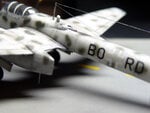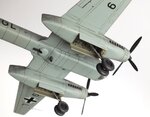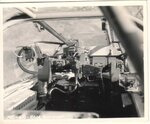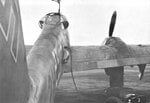Steam powered, perhaps?
There were proposals for steam turbine powered Me 264 and He 177 that used a 70% coal, 30% diesel slurry. So it makes sense to tap of some of the steam to power the various servo mechanisms of the aircraft.
Follow along with the video below to see how to install our site as a web app on your home screen.
Note: This feature may not be available in some browsers.
Ad: This forum contains affiliate links to products on Amazon and eBay. More information in Terms and rules
Steam powered, perhaps?
The single gun EDL 131 was clearly designed for minimum drag. British aircraft might have done well to have this low drag light weight turret. The single MG131 had as much muzzle kinetic energy as twin 303 brownings and as much throw weight with more penetration and a bullet 2.7 x bigger and clearly was a smaller turret.
Periscope sighted turrets proved to be virtually useless in combat. The extremely limited field of vision made target acquisition very very difficult and even if acquired, tracking proved to be a problem. The British had little success with their various Frazier Nash turrets. The Americans abandoned the Bendix ventral turret developed for the B-25. Sperry developed the ball turret to replace their periscope sighted ventral turret. The USSAF tried to reuse existing Bendix ventral turrets as the original B-17 chin turrets, but found that while the front nose position would make acquisition easier, tracking was stiil too difficult. The sighting arrangements had to be completely redesigned before the chin turret was introduced.The Ju 89 V1 flew in 1936 with 750hp engines, the Ju 89 bomber program was cancelled the day after the aircrafts maiden flight. The same fate befell the Dornier Do 19.
In 1937 the cancellation extended into an order to cease all work. Nevertheless the Ju 89 V2 with 900hp DB600 engines was allowed to fly as part of the Ju 90 transport program. The Ju 89 V3 was under construction at this point and was meant to be the first armed prototype. The Do 19 V1 never got passed its 680hp radial engines.
By December 1939 the Ju 90V5 with its wing span extended 11% and removal of the Junkers double flap was flying with Bramo 139 radial engines. That shows how fast progress could have been. The Ju 90V6 featured the trappoklappe rear loading ramp. These were essentially the Ju 90B. Bomber versions for the Ju 90B were ordered which essentially became the Ju 290 by 1941.
The Ju 89V2 set some spectacular load and load to height records. Luftwaffe Secret Projects gives one of the armament options as MG131 in the tail. It lists speed as 242-255mph with 4400lbs of bombs and a range of 1850miles carrying bombs. The MG 131 was in low rate production by 1938 for experimental purposes so maybe it crept into planning documents The MG34 belt fed MG81 (1300rpm) was available by the BoB and making appearances as a retrofit for the MG15 where suitable.
The Ju 89/Do 19 aircraft had some limitations in that their low wings would have forced a B17/Ju 52/He 111 style bomb bay but doubt this was a serious limitation.
The Do 19 obviously could have enjoyed an aerodynamic clean-up around its braced tail and its 2 dimensional folded nose and glass house. It was after all a prototype.
The lack of turrets on German bombers has little to do with the lack of ability to produce power turrets: it is explained primarily by the factor that the performance penalty of gun turrets on 2 engine bombers starting with 700hp and engines with 1000-1100hp engines by 1940 is simply too much eg He 111 and Do 17. The B25 and B26 needed CW R-2600 of 1600hp+ and the B26 needed PW R-2800 of 1850hp. The Wellington on the 1050hp Taurus was underwhelming at 235mph and needed the Merlin XX or Hercules. The Germans had 1350hp in later 1941 and 1450 in 1942 with Jumo 211F and J. The1560hp BMW 801A couldn't be spared for bombers except in very small numbers.
I can not see a technology problem in producing a hydraulic powered turret in 1838 for the Luftwaffe. Either a pressure compensated hydraulic flow control valve is used to control the traverse rate of a reversible swash plate variable displacement pump is used. These devices are not some unique British technology at the time.
Every indication is that the Luftwaffe wanted to bypass manned turrets completely so did not invest much in power turrets. The Bomber B (Ju 288) was completely defended by remote controlled guns using periscopic sights to eliminate parallax error. The Bomber A (He 177) was likewise to be defended by remote control guns in the dorsal and ventral forward firing area ie anything outside of the manned tail gun and rearward facing bathtub gun.
The Fw 200 was an airliner. The maritime reconnaissance bomber version came out of a private order placed by the Japanese Navy and seized by the Luftwaffe. Until the Bramo 323 received water injection and reached 1200hp a large power driven turret also had a performance penalty.
That leaves the Do 217 as the only bomber sand it seems to have only been an interim and the Ju 90S/Ju 290 which plodded along as an after thought.
The manned power Dorsal turrets used seem to be the 20mm FW 19 (a focke-wulf designed fully hydraulic unit used on the Fw 200 and the 20mm hydraulic HL 151/20 or HL 151/15 used on the Fw 200, Ju 290, BV222, Me 232 and several flying boats).
The MG 131 was in low rate production in 1938, seemingly for testing, The issue of using 30,60,90 round drum magazine for the MG FF gets down to reload times for the bigger magazine versus less frequent reloads.
The single gun EDL 131 was clearly designed for minimum drag. British aircraft might have done well to have this low drag light weight turret. The single MG131 had as much muzzle kinetic energy as twin 303 brownings and as much throw weight with more penetration and a bullet 2.7 x bigger and clearly was a smaller turret. The manual elevation is unlikely to be an issue given the short barrel protrusion into the slipstream.
The Ju 89 can be ready by 1939. Its probably not a spectacularly fast aircraft, due to the low engine power available at that stage but then 260mph seems to have been the norm. I would expect a 20mm power driven dorsal turret, 20 mmm ventral gun in a bathtub, tail gun (possibly MG81) He 111 style waist guns and nose guns. If the dorsal turret isn't possible I would expect a He 111 style installation with an MG15 and a similar installation with a MG FF with limited deflection.
Its a lot better than a Fw 200 and capable of significant development as the Ju 290 showed. The effect on the BoB is to force a greater dispersal of RAF fighter command, an more effective anti shipping weapon and attacks in the North of Scotland.
Periscope sighted turrets proved to be virtually useless in combat. The extremely limited field of vision made target acquisition very very difficult and even if acquired, tracking proved to be a problem. The British had little success with their various Frazier Nash turrets. The Americans abandoned the Bendix ventral turret developed for the B-25. Sperry developed the ball turret to replace their periscope sighted ventral turret. The USSAF tried to reuse existing Bendix ventral turrets as the original B-17 chin turrets, but found that while the front nose position would make acquisition easier, tracking was stiil too difficult. The sighting arrangements had to be completely redesigned before the chin turret was introduced.
Low drag turrets were comprised by the limited field of vision. The USAAF enlarged both the Sperry upper turret of the B-17 and the best turret of the war, the Martin upper turret, to improve visibility and they were larger than the German turrets to begin with.
Remote turrets introduce problems of their own. Two separated devices must be synchronized to operate in harmony. This is further complicated by the parallax problem requiring a more accurate assessment of range. The remote mounting had to point in a somewhat different direction than the sight. These calculations had to be made by analog vacuum tube computers.




It must be borne in mind that Soviet factories occupied a much larger portion of territory than their English, German and Japan counterparts as, to the contrary, there were no land space problems in the Soviet Union. Given the very low precision of the bombings of those times, the number of missions necessary to destroy the plants of the factories would have been impossible for the Luftwaffe to sustain, because most of the bombs would not have fallen on the sheds but on the surrounding open areas.
A very simple cost / benefit analysis immediately showed the Luftwaffe the futility of the strategic bombing of the Soviet Union, with any type of bomber conceivable at the time, regardless of the numbers of the engines.
properly developed Ju 89/Do 19
Periscope sighted turrets proved to be virtually useless in combat. The extremely limited field of vision made target acquisition very very difficult and even if acquired, tracking proved to be a problem. The British had little success with their various Frazier Nash turrets. The Americans abandoned the Bendix ventral turret developed for the B-25. Sperry developed the ball turret to replace their periscope sighted ventral turret. The USSAF tried to reuse existing Bendix ventral turrets as the original B-17 chin turrets, but found that while the front nose position would make acquisition easier, tracking was stiil too difficult. The sighting arrangements had to be completely redesigned before the chin turret was introduced.
... the best turret of the war, the Martin upper turret ...
The Lofte and StuVi are available from 1942 and the Hs 293 and Fritz-X sometime thereafter some accuracy can be expected.
The Ju 288 was manufactured in giant presses and use very little man power. Eg the 4 taper spars of the wing were pressed in one operation.
Possibly.Looking at this question from a different angle. If Germany had a four engine bomber and had attacked Russia instead of France, then that could have ultimately been a winning strategy.
The FN64 turret's lack of success had more to do with the fact that Bomber Command operated mainly at night -- not any problem inherent with periscopically-sighted under turrets.
By all British accounts the Bendix K turret was markedly inferior to the FN64 and after testing in the Mitchell recommended that "... this turret should be replaced by the F.N.64 under turret at the earliest possible date."
Must .. resist ... further ... thread derailment ....
France declared war on Germany and invaded the Saar part of Germany and occupied it for nearly a month. Wasn't really a choice by then. There was an attempt by Hitler, as part of territorial dispute resolution, to offer a mutual Polish-German anti Soviet pact with the Polish government against the Soviets. Poland and Germany invading Russia is quite plausible.Looking at this question from a different angle. If Germany had a four engine bomber and had attacked Russia instead of France, then that could have ultimately been a winning strategy.
How many of them would be needed to destroy a Russian tank factory?
It was not only a matter of the manpower necessary to build them: it was the "manpower" to operate that planes that Luftwaffe could not afford (and, of course, the avgas...).
Properly developed means throw out and start over.
The US had the Boeing B-15 flying in 1937, They weren't stupid enough to put it into production even with better engines.
They took what they learned from it in regards to structures and aerodynamics and designed new airframes. Consolidated didn't want to build the B-17 under license when approached by the AAF in 1938. In Jan 1939 they made a proposal to the AAF that lead to the B-24. Consolidated just managed to get the prototype completed and first test flight on Dec 29th 1939.
The Germans should have flown the prototypes they had and started over in late 1937/early 1938.
The two bombers had too many problems what with oversized wings and questionable airfoils/aerodynamics. Even Junkers gave up on the double wing system with the JU 88 for high speed flight and using the double wing system on the elevators? The Fuselages were oversized for the job of bomber and undersized for a transport. The Ju 89 had 14% more wingarea than a B-29 and just under 40% more area than a B-17. That is a lot of extra drag (and weight) to be carting around with the available engines if you are trying for speed
.
I admit to not remembering that. My logic was that a large proportion of Russian industrial strength would have been in range and Russia didn't have much in the way of defences at altitude. The Mig 3 is the obvious exception, but 1 x HMG and 2 x LMG it's effectiveness must be in question.France declared war on Germany and invaded the Saar part of Germany and occupied it for nearly a month. Wasn't really a choice by then. There was an attempt by Hitler, as part of territorial dispute resolution, to offer a mutual Polish-German anti Soviet pact with the Polish government against the Soviets. Poland and Germany invading Russia is quite plausible.
How any military of the day did:Which does beg the question of how they find factories that are scattered far from the front so they can try to bomb them.
I specifically mention the Ju 288 because it had force multiplier effects. It was classified as a heavy bomber by the Luftwaffe and carried more than a B17.
1 Only 4 crew for the Ju 288B and Ju 288C. For the original Ju 288A it was 3 crew and less demanding engines.
2 It's speed of around 400mph (more or less the three models had speeds of 388, 402, 428) and a very high cruising speed means missions of 900 miles radious will take less than 6 hours allowing aircraft to operate multiple missions. One reason the Jumo 222 was chosen over the DB604 was apparently faster cruise the Jumo offered.
The aircraft seems a lot cheaper to man and operate than a big 4 engine aircraft. Of course we know the engines didn't come to maturity in time and the plan B engines failed as well.
<SNIP>
Which does beg the question of how they find factories that are scattered far from the front so they can try to bomb them.
How any military of the day did:
Aerial recon
Transmission interception
Information gathered from captured personnel